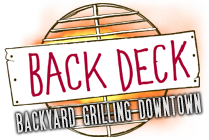Fire is the beginning of all cooking, but particularly grilling. Before you can master grilling you must first master fire.
To build a fire you need to create two opposite conditions. Fire needs plenty of oxygen (air), but, at first, it needs to hold in as much heat as possible to keep the fire going. When you use wood you want to stack the logs close together so that they hold in the heat, but with enough room between them to allow air to flow. The other thing to consider is that hot air rises (this is called convection), so we want to let the air in at the bottom and let the hot air (which has less oxygen now) out the top.
You want an efficient way to create these conditions to start the charcoal burning quickly. The best way to do this is to use a metal tube called a chimney. The chimney has two chambers separated by a screen, a small chamber at the bottom that holds the kindling, which burns easily and ignites the charcoal, which is held in the upper chamber. The idea here is that the heat generated by the kindling – usually a wadded up piece of paper – is quickly carried upwards by convection, which lights the bottom charcoal. Because the tube is only open at the top, with a few holes at the bottom, the heat does not spread, except for what is carried up, and so the fire spreads up until all the charcoal is lit, in about 5 minutes.
When the charcoal in the chimney is good and hot you will pour it onto your grill, which contains more charcoal. So you want to pour the charcoal in a heap in the middle, and then surround it with the unlit charcoal, so that the unlit charcoal can quickly catch fire. After it is all lit you can spread it out, which brings us to the next step, creating the kind of fire you want to cook over: an even fire.
One of the keys to good grilling is an even fire. The only variations in heat should be the ones you plan for. You will want a hot area to sear over, a medium area to do most of the cooking and a cooler area for gentler cooking. If you will be cooking for several hours, like slow cooking a turkey or ribs, you will need to add charcoal over time. This requires some planning and constant maintenance. Since charcoal starts out burning very hot and gradually losses heat, your fire will be hottest where your have lately added charcoal that has just ignited. If you run into problems there are a few things you can do to quickly change the conditions of your fire. If you need a section hotter there are two things you can do: stir up the coals, which makes the ashes covering them fall to the bottom, and direct more air on it by blowing, using a fan or a bellows. Both of these techniques add oxygen, which makes the coals burn faster and hotter. To cool a section you can spray it with water, or, to cool the whole grill you can cover it, cutting down on the available oxygen.
For proper airflow in a charcoal grill you need to remove accumulated ashes from the bottom before starting the fire. Since charcoal requires oxygen to burn, anything blocking the vents will reduce the heat generated by the coals.
Now that you have your fire going here is how to judge how hot it is.
- Very hot: You can hold your hand at grill level only 1 to 2 seconds.
- Hot: You can hold your hand at grill level only 2 to 3 seconds.
- Medium-hot: You can hold your hand at grill level only 3 to 4 seconds.
- Medium: You can hold your hand at grill level only 4 to 5 seconds.
- Medium-low: You can hold your hand at grill level only 5 to 6 seconds.
- Low: You can hold your hand at grill level only 6 to 7 seconds.
